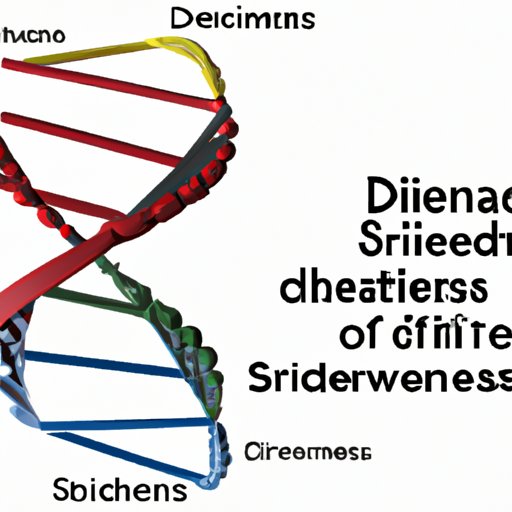
Introduction
The diathesis stress model is a psychological theory that aims to explain the interactions between genetic predisposition and environmental factors that can lead to mental health disorders. In this article, we will explore the key features of the diathesis stress model and its relevance in understanding the nature vs. nurture debate in mental health.
Understanding the Diathesis Stress Model: Exploring the Links Between Nature and Nurture
The diathesis stress model is a theoretical framework that suggests that mental health disorders are the result of an interaction between genetic predisposition (diathesis) and environmental factors (stress). This model proposes that individuals with certain genetic vulnerabilities are more susceptible to stress-induced mental health disorders. Their genetic predisposition is referred to as a diathesis or vulnerability, and it interacts with environmental stressors to create a risk for mental health disorders.
The diathesis stress model recognizes that both nature and nurture contribute to the development of mental health disorders. Genetics can predispose an individual to develop mental health disorders, but it is the interaction with environmental stressors that can ultimately lead to the manifestation of these disorders. Environmental stressors, such as trauma, abuse, or social isolation, can trigger genetic vulnerabilities and exacerbate mental health disorders.
Research shows that nature and nurture interact in complex ways in shaping mental health outcomes. For example, genetic predispositions can increase the risk of depression in response to stressful life events, and environmental factors can turn on or off gene expression associated with mental health disorders.
The Diathesis Stress Model: How Environmental Factors Can Trigger Genetic Predispositions
The diathesis stress model proposes that environmental stressors can trigger genetic vulnerabilities and increase the likelihood of developing mental health disorders. Stressful life events, such as job loss, divorce, or the death of a loved one, can cause biological changes that impact mental health. Cortisol, the stress hormone, is released during stressful situations, which can disrupt neural circuitry and cause chemical imbalances in the brain, leading to mental health problems.
However, not everyone is equally affected by stress, and genetics play a significant role in determining stress susceptibility. An individual’s genetic predispositions, including genes that regulate the body’s response to stress, can shape their responses to environmental stressors. For example, the COMT gene has been found to increase the risk of depression in individuals exposed to stress.
Environmental stressors also interact with genetic factors that regulate neurotransmitter systems, such as the serotonin transporter gene (5-HTTLPR) which has been associated with increased susceptibility to stress-induced depression.
Mental Health and the Diathesis Stress Model: A New Perspective Emerges
The diathesis stress model is a significant framework in understanding mental health disorders, suggesting that both genetic and environmental factors contribute to the onset of mental health disorders. Mental health professionals have used this model to explain how stress interacts with genetic vulnerabilities and how an understanding of these interactions can inform prevention and treatment strategies.
This perspective has led to new insights into the development of mental health disorders. For example, a 2018 study found evidence that childhood abuse alters gene expression and increases the risk of developing depression and anxiety disorders, providing new opportunities for research on the genetic mechanisms underlying mental health disorders.
Exploring the Diathesis Stress Model: The Importance of Identifying Risk Factors
Identifying risk factors for mental health disorders is an important step in reducing the impact of mental illness. The diathesis stress model recognizes that understanding an individual’s genetic predispositions and the environmental stressors that trigger them can inform preventative measures, such as cognitive-behavioral therapy, mindfulness-based stress reduction, and other therapeutic approaches.
Risk factors for mental health disorders include childhood trauma, chronic stress, family history of mental illness, and social isolation. By identifying these risk factors, mental health professionals can create personalized treatment plans that address an individual’s specific genetic and environmental vulnerabilities.
A Closer Look at the Diathesis Stress Model: Why It Matters in Mental Health Treatment
The diathesis stress model plays an essential role in developing effective mental health treatment plans. By understanding an individual’s genetic predispositions and the environmental stressors that trigger them, mental health professionals can create a personalized treatment plan designed to reduce the risk of mental health disorders.
For example, individuals with a genetic predisposition to depression can benefit from cognitive-behavioral therapy, which teaches them to recognize negative thoughts and replace them with positive, constructive thoughts. Mindfulness-based stress reduction techniques can help individuals with chronic stress lower their stress levels and reduce the risk of depression and anxiety disorders.
Conclusion
The diathesis stress model proposes a new framework for understanding the links between genetic predisposition and environmental stressors in the development of mental health disorders. Understanding this model is essential for mental health professionals to determine prevention and treatment strategies that take into account an individual’s specific genetic and environmental vulnerabilities. Through identifying risk factors and personalized treatment plans, mental health professionals can help individuals manage their mental health and improve their overall quality of life.





